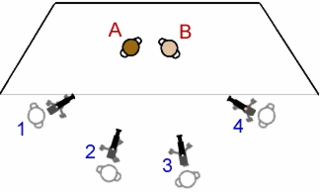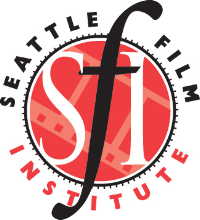
16 mm film is a historically popular and economical gauge of film. 16 mm refers to the width of the film; other common film gauges include 8 and 35 mm. It is generally used for non-theatrical film-making, or for low-budget motion pictures. It also existed as a popular amateur or home movie-making format for several decades, alongside 8 mm film and later Super 8 film. Eastman Kodak released the first 16 mm "outfit" in 1923, consisting of a camera, projector, tripod, screen and splicer, for $335. RCA-Victor introduced a 16 mm sound movie projector in 1932, and developed an optical sound-on-film 16 mm camera, released in 1935.

Super 8mm film is a motion picture film format released in 1965 by Eastman Kodak as an improvement over the older "Double" or "Regular" 8 mm home movie format.
The following is a list of video-related topics.

A camera operator, is a professional operator of a film or video camera. In filmmaking, the person designing the lighting is the cinematographer or director of photography. A camera operator in a video production may be known as a television camera operator, video camera operator, or videographer, depending on the context and technology involved, usually operating a professional video camera.
Filmmaking is the process of making a film, generally in the sense of films intended for extensive theatrical exhibition. Filmmaking involves a number of discrete stages including an initial story, idea, or commission, through screenwriting, casting, shooting, sound recording and reproduction, editing, and screening the finished product before an audience that may result in a film release and exhibition. Filmmaking takes place in many places around the world in a range of economic, social, and political contexts, and using a variety of technologies and cinematic techniques. Typically, it involves a large number of people, and can take from a few months to several years to complete.

A videographer is a person who works in the field of videography and/or video production, recording moving images and sound on video tape, digital, or any future data storage medium, disk, other electro-mechanical device. News broadcasting relies heavily on live television where videographers engage in electronic news gathering (ENG) of local news stories.
Offline editing is part of the post-production process of filmmaking and television production in which raw footage is copied and the copy only is then edited, thereby not affecting the camera original film stock or video tape. Once the project has been completely offline edited, the original media will be assembled in the online editing stage.
Television crew positions are derived from those of film crew, but with several differences.

The multiple-camera setup, multiple-camera mode of production, multi-camera or simply multicam is a method of filmmaking and video production. Several cameras—either film or professional video cameras—are employed on the set and simultaneously record or broadcast a scene. It is often contrasted with single-camera setup, which uses one camera.

Cal State LA Studios is the production area of the Department of Television, Film, and Media Studies at California State University, Los Angeles, the only CSU campus in the Los Angeles basin. Bachelor of Arts degrees are offered in Telecommunications and Film, Broadcast Journalism and Animation. Master of Arts degree programs include Screenwriting and Critical Studies as well as a three option Master of Fine Arts (MFA) program in Dramatic Writing, Production/Direction, and Performance in Television, Film, & Theatre Arts. Production facilities and equipment include: 3-camera digital television studios, dedicated news studio, nonlinear postproduction workstations, postproduction labs and individual editing suites, 16mm motion picture camera kits, DV and HDV camera kits, field lighting kits, and misc. grip equipment. In 2014 the department open a new building, the Television, Film and Media Studies Center with a new sound stage and audio post production facilities.

A home movie is a short amateur film or video typically made just to preserve a visual record of family activities, a vacation, or a special event, and intended for viewing at home by family and friends. Originally, home movies were made on photographic film in formats that usually limited the movie-maker to about three minutes per roll of costly camera film. The vast majority of amateur film formats lacked audio, shooting silent film.

The Northwest Film Center (NWFC) is a regional media arts resource and service organization based in Portland, Oregon, United States that was founded to encourage the study, appreciation, and utilization of film. The center provides a variety of film and video exhibition, education and information programs primarily directed to the residents of Oregon, Washington, Idaho, Montana and Alaska.
The International Academy of Film and Television (IAFT) is a trade film school offering diploma and certificate programs in filmmaking, acting, and 3D animation. IAFT includes significant amounts of hands-on practical experience under the care and guidance of recognized industry mentors in its programs. IAFT Cebu was also voted as "one of the best film schools in the world" by the Hollywood Reporter.
Articles related to the field of motion pictures include:
Clusters College For Media & Design/Clusters School of Digital Arts is one of the largest film, visual effects, television, animation and media arts institute in India, providing education in technical aspects of the media and entertainment industry. Courses vary in duration from 6 months to 18 months, full-time and part-time

The Department of Radio–Television–Film at the University of Texas at Austin located in Austin, Texas, is one of the five departments comprising the Moody College of Communication. The department was founded in 1965 and has become one of the nation's premiere film schools, consistently ranking in the top 5 for graduate programs and the top 10 for undergraduate studies. The department has a very selective admissions policy, accepting fewer than 25% of applicants in its undergraduate program, and fewer than 15% of applicants in its graduate programs.

Multi-image is the now largely obsolete practice and business of using 35mm slides (diapositives) projected by single or multiple slide projectors onto one or more screens in synchronization with an audio voice-over or music track. Multi-image productions are also known as multi-image slide presentations, slide shows and diaporamas and are a specific form of multimedia or audio-visual production.

The Digital Film Academy (DFA) is a for-profit art and design college located in Manhattan, New York, founded in 2001.















